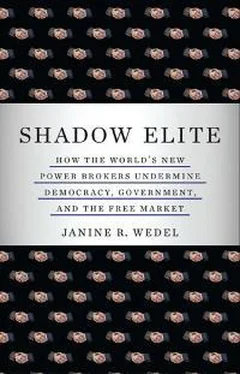Government that literally doesn’t know what it’s doing can scarcely be operating effectively. Moreover, it becomes vulnerable on all fronts.
Emasculated Government
Wrapped up with the shifting balance and transfer of functions from state to private is not only the privatization of should-be official information, but also the privatization of legitimacy, expertise, institutional memory, and leadership, which, in turn, relegates information to private hands. It is telling that, nowadays, not only are salaries and perks for comparable jobs typically greater in the private sector, but, often, so is prestige (though benefits are often inferior).
The draining of official government appears to be widespread, and it is depriving the government of crucial in-house expertise and institutional memory. Take, for example, the Department of Homeland Security. During fiscal years 2005 and 2006, according to the GAO, more than half the senior employees at the department’s headquarters either resigned or transferred to another executive branch department. DHS’s Federal Emergency Management Agency, even before hurricanes Katrina and Rita, lost the services of demoralized professionals. This and the recruitment of government talent by private industries are a general problem. CIA director Michael Hayden complained in 2007 that his agency had begun “to look like the farm system for contractors around here.” In response, agency officials banned some companies from soliciting in their cafeteria. 41
The problem is not that intelligence and military professionals are switching between the state and the private sector, a pattern that accompanied the ascent of the military-industrial complex. As a reporter who has investigated the issue observes: “What we have today with the intelligence business is something far more systemic: senior officials leaving their national security and counterterrorism jobs for positions where they are basically doing the same jobs they once held at the CIA, the NSA and other agencies—but for double or triple the salary, and for profit. It’s a privatization of the highest order, in which our collective memory and experience in intelligence—our crown jewels of spying, so to speak—are owned by corporate America.” 42
Is government losing its soul? While it may be strange to mention “soul” and government in the same breath, linking the quintessentially personal with the quintessentially bureaucratic and impersonal, a government procurement lawyer described the state of affairs as the “ebbing away of the soul of government.” 43
Perhaps it is not only government that is losing its essence and edge. Think of the companies that work mainly or exclusively for government. When a contractor becomes, for all practical purposes, another branch of Government, Inc.—just a little further out on the Beltway—what happens to its competitiveness, risk, innovation, and dynamism, private sector qualities that are supposed to make it attractive and beneficial to government? Booz Allen, for instance, separated its government business (which has thrived with new megacontracts since 9/11) from its commercial business (which has not) in 2008. The split was prompted by the diverging directions of its government and commercial units as evidenced in differing cultures, employees, and retention practices, according to the head of the new management consulting company, Booz & Co. While the commercial unit tends to recruit business school graduates and either promote them quickly or discard them, the government unit recruits from government, military, and engineering entities and retains employees in the same positions for years. When companies or units thereof dedicate themselves wholly to government business, those private-sector qualities that supposedly justified contracting in the first place may not apply. 44
The marriage of bureaucracy and business may be mutually profitable, and the two members of the couple may look more and more alike, but there are significant differences. Each is fundamentally constrained and enabled by different incentives and laws. This is especially obvious when it comes to the blended workforce. Whether they perform as a government official or a private contractor, individuals not on the government payroll are subject to more relaxed (or ambiguous) rules governing conflicts of interest and ethics than are civil servants. Whether the rules that apply to civil servants should pertain to contractors is an area of active policy discussion. Be that as it may, the official workforce is governed by a host of statutory provisions that do not concern contractors. 45
The disparity in the application of regulations to civil servants and to contractors performing the same work raised concern even in some quarters of the executive branch of the Bush II administration, which prided itself on its record of contracting out. In August 2002, the Office of Government Ethics, a small, independent, federal government agency, sent a letter to attorneys and ethics officials in nineteen government agencies inviting comment on “whether federal contractors raised conflicts of interest problems or concerns and, if so, whether such problems can best be solved by applying regulations” to the contractors. Amy Comstock, the Office of Government Ethics director (a Clinton appointee serving a fixed term), noted, “In many agencies, federal employees and contractor personnel work side by side [in official office space] on the same projects. Yet there are different ‘ethics’ rules for these employees.” Then she inquired: “Does this make sense?” 46
The underlying reality is that, even as government and business try to accomplish common tasks, the two have inherently divergent purposes. While companies are expected to make money for their shareholders, and have a fiduciary duty to do so, government is supposed to be accountable to the public. Companies, unlike government, have no obligation to “stay the course” when the going gets tough.
Such an uneasy relationship spawns arenas of the state where it is responsible but has little control. This can hardly bode well for the efficacy of federal governing.
“Competition” Without Competing
So far we’ve seen who comprises government and who controls it—in short, the architecture of the system. A look at the reforms instituted during the Clinton administration helps explain how new institutional forms of power and influence have gathered force with this evolving architecture as the backdrop. Again, the privatization of information is basic to the emasculation of government, from the depletion of information away from its agencies to the removal of information about contracts and the contracting process from the public.
The administration of President George H. W. Bush did little to expand the role of contractors (and in fact presided over a number of contract oversight investigations). But the opposite is true of the Clinton administration, which introduced regulations and statutes in the procurement system that ushered in noncompetitive network-friendly practices that are substantially hidden from government overseers and accountability. Contracting rules established under Clinton paved the road for the actions of his successor. A top government procurement official whose tenure spanned the administrations of George H. W. Bush, Bill Clinton, and George W. Bush, said it succinctly: “Clinton laid the framework and set the speed limit at 500 miles per hour but never drove the car past 250. Bush tested the limit.” 47
The crux of the story is this: Under the rubric of “reinventing government” and deregulation, the Clinton administration transformed contracting rules with regard to oversight, competition, and transparency. Here the activities of Steven Kelman, the flexian and government contracting guru (who coined the term the “evolving door”), are important. Kelman worked with industry associations, including the Acquisition Reform Working Group and the Professional Services Council, as well as Congress, particularly with Democratic Leadership Council supporters and Republicans, to make government purchasing faster for the agencies and “friendlier” for contractors. Many of these industry-energized reforms were embodied in the Federal Acquisition Streamlining Act (FASA) of 1994 and the Federal Acquisition Reform Act (FARA) of 1996. 48
Читать дальше












